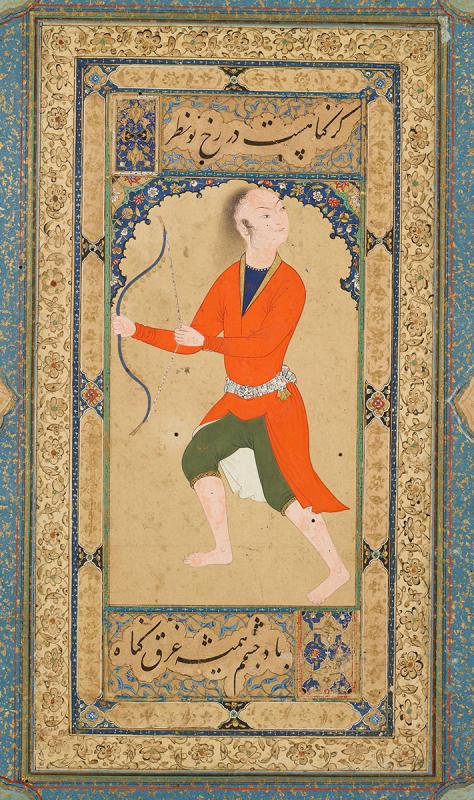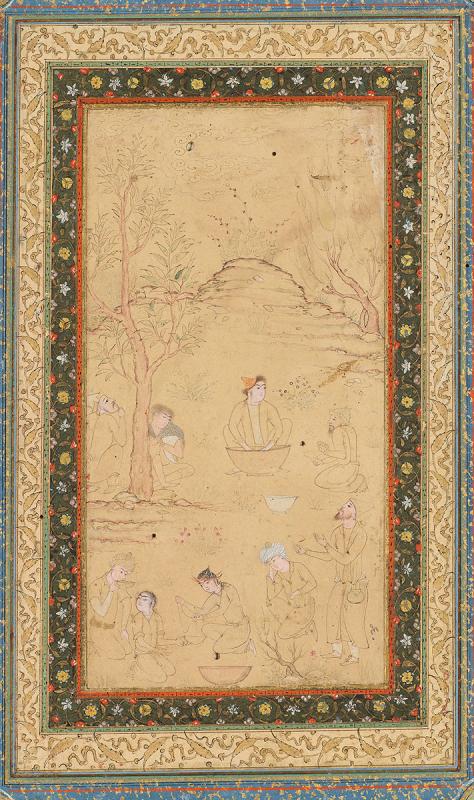In 1911, Pierpont Morgan purchased fifty-seven leaves of Persian and Mughal miniatures and calligraphy. Orchestrated largely through the efforts of Belle Da Costa Greene, Morgan’s librarian, the acquisition marked a turning point in the history of the Islamic collections at the Morgan. A core set of these leaves once formed part of a magnificent album compiled for Husain Khan Shamlu (r. 1598–1618), governor of Herat (Afghanistan) and one of the most powerful rulers in Persia in the early seventeenth century. Although their original sequence remains unknown, the album leaves were likely bound accordion style, alternating pairs of miniatures with pairs of calligraphy samples. Known as muraqqa’s, such albums were assembled by mounting disparate work—from various artists, calligraphers, and time periods—onto standard-sized sheets, which were then framed with highly ornamented papers. As composite objects, such albums reflected the learning and refinement of their compilers. Their format also encouraged a heightened awareness of artistic traditions as illuminators and calligraphers copied and responded to one another, engaging in a creative dialog that often crossed both generations and genres.
The practice of album making was particularly strong in Safavid Iran, in the sixteenth and seventeenth centuries. At this time, innovative painters began to move away from the traditional format of illuminated manuscripts toward single-page compositions created specifically for the album format. Along with this shift, an interest in new subject matter developed, often drawing on themes of contemporary poetry. Particularly popular were paintings of idealized youths, usually depicted as languorous, carefree, and elegantly dressed. Not portraits in the conventional sense, but rather embodiments of beauty and objects of desire, these youths evoke the rapturous descriptions of the beloved, which was a favorite subject of lyric poets at the time.
One particularly elegant portrait epitomizes many of the essential qualities of beautiful youths in Safavid art: an effortlessly poised figure, fashionably dressed, and languidly detached from any cares or concerns. The development of such portrayals can be linked to the celebrated artist Riżā ˓Abbāsī, who was a pioneer both in terms of his subject matter and his technique. Proficient in many styles, Riżā perfected a manner of drawing that features expressive penwork combined with light tints of color (nīm-qalam technique). While not attributed to the master himself, this work may have been done by a talented follower. Particularly noteworthy is the detailed treatment of the fur lining the youth’s coat, as well as the virtuoso rendering of his turban.
On another such leaf, a youth is shown kicking off his slippers while adjusting his glove. He gazes at the alert falcon perched on his knee. Also executed in the nīm-qalam technique, the majority of the figure was drawn using only brown and red inks with light tints of color, while gold and pigments were added to emphasize certain details such as the falcon, the youth’s ornate turban, and his glove. As if extolling the youth’s beauty, the inscription added to the panels above and below the figure claim that “the moon cannot set its face against yours. If it did, everyone would find fault with the moon.”
Barefoot and wearing the traditional short trousers of Persian strongmen, another such youth is shown exercising, flexing an ornate bow lined with gold discs. Aside from a decorative archway, the setting for the athlete is a background of plain paper. While the depiction of his clothing is similarly restrained, the artist has lavished attention on the delicate features of the youth’s face, particularly the extremely fine, almost feathery locks of hair at the top and sides of his head. That the athletic youth is presented here as an object of beauty can be gleaned from the text panels above and below the figure, which state: “If it is a sin to gaze upon your face, then let my eyes be ever drenched in sin.”
Unlike the majority of these works, which focus on single figures, one of the miniatures depicts nine men in the process of mixing and drinking wine and bang (hashish). They are grouped as pairs, each composed of a youth and an older man, the youth without a partner in the lower center is serving the others. The youths are idealized beauties. The older men, in contrast, are caricatured with unflattering features—a visual distinction that underscores the comedic nature of their courtship. An inscription from a related scene in the album conveys the intended revelry: “Now that the flower of happiness is bearing fruit, why is your hand empty of a wine goblet? Drink wine, for time is a treacherous enemy, and it is difficult to find a day like this.”
Rarely outright erotic, the miniatures and their related verses of poetry place an emphasis instead on the appreciation and pursuit of beauty through a devotion to the beloved that can, at times, reach melodramatic heights. In one of the album’s calligraphy leaves, for example, a poet says of his beloved, “I have wished that your eyes would once again kill me…” These miniatures of beautiful youths serve as fitting manifestations of this all-consuming desire for true beauty. As such they offer us a glimpse into a highly refined court culture where poetry and painting, beauty and desire mingle on the pages of an album.
Joshua O'Driscoll
Assistant Curator
Medieval & Renaissance Manuscripts
The Morgan Library & Museum





